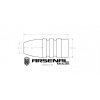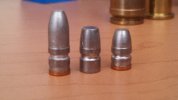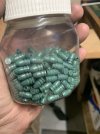I have two loads for the Hornet. In my 219, I shoot the NOE 45 grain WFN, which I ordered mine with all plain bases. I use two grains of Bullseye and a small pistol primer. This is squirrel head accurate at 25 yards which is realistic small game range to me. That combo quickly became my favorite woods rifle. I usually sit against a tree and wait for them to show, getting shots in that range is usually not a problem.
The other load is one I use in a Stevens 322 which doesn't seem to want to feed that WFN design. I got one of the Bator molds Midsouth used to sell, good design, they should bring it back. I cast a pot of these very soft, attempting to get that 1% antimony that .22 LR bullets have. I gas check it, size to .225 and shoot in front of six grains of 2400. Quite a bit more power than the Bullseye load, never chronographed it, but it shoots and kills well.
At some point, I picked up one of the original Ranchdog designs, but haven't tried it out yet, it might be better than that Lee Bator. That Bator design, by the way, is nominally 55 grains, but is actually shorter than the Lyman 225348 and I've had no problems getting good groups in the old slow twist rifles I use.



